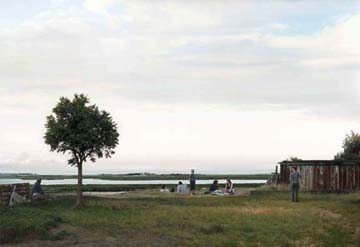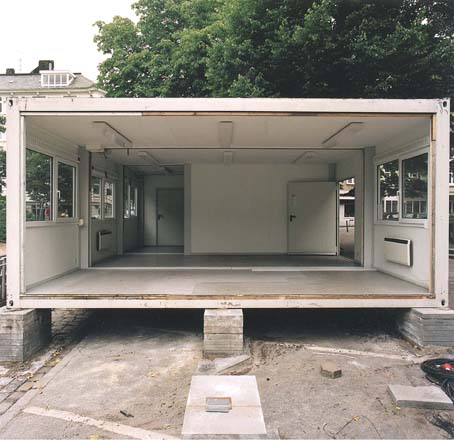Utopia’s Backyard

About the Exhibition
Work by:
Peter Dombrowe
Jeanne Faust and Jorn Zehe
Beate Gütschow
Peter Piller
Clumps of trees, sleeping houses, garbage sculptures, and life in suburbia
Paintings lie; only the incorruptible eye of the camera can be trusted—so the Russian artist Aleksandr Rodchenko claimed in the 1920s. Today people might still find disappointing confirmation of this “truth” in the photographs they take on their Italian holiday. The tourist will choose an appealing view and select an angle that displays the motif in a particularly flattering and compositionally balanced light. But on releasing the shutter, what the photograph reveals is simply what struck the film through the lens. His choice of subject will probably still be informed by the grand tradition of landscape painting from the seventeenth to the nineteenth centuries. But a photograph is no match for such models of inspiration. Hardly surprising, given that classical landscapes, inspired largely by Claude Lorrain, the French-born painter who later moved to Rome, are certainly not depictions of what is found in nature. Such idealized notions of Italian landscape were supplemented with architectural elements suggestive of the Golden Age and furnished with the mythological staffage of antiquity. In other words, classical landscape is little more than a collage, but without all the tears and cuts.
Beate Gütschow explores the tradition of the pastoral idyll by photographic means. It is not from pen-and-ink sketches, but from twenty or thirty photographs taken by the artist when she is out walking that she generates on the computer each composite image of a seemingly coherent landscape. On closer inspection, however, even the snap-happy tourist will soon begin to doubt whether he has really found the fulfilment of his futile dream in these rural depictions. After all, how is the artist supposed to have conjured up her Arcadian scenery when faced with all those campers in jeans and T-shirts? Or the rolling parkland with clumps of trees that not even the consummate English Romantic painter John Constable could have depicted more atmospherically?
In Rodchenko’s times it was not that easy to manipulate photographs. But he too had to witness how his faith in the veracity of the photographic image was grievously belied during the era of Stalinist purges. Party officials who had fallen from grace were removed not only from public view, but also from photographs. Yet even today photographs still serve as items of legal or scientific proof. Four decades after Kennedy’s assassination in Dallas, snapshots taken that day by tourists or bystanders continue to be examined for chance signs of snipers in the unrelenting attempt to finally find the “true” killers. The authors of these pictures were presumably just as unaware of what they had (possibly) photographed as was the photographer played by David Hemmings in Antonioni’s 1966 film Blowup, whose pictures offer indisputable proof of the murder in the park. The exclusion of all such accidents beyond the control of the photographer had long been considered a key feature of artistic photography. And even today, many photographic artists still endeavour to simulate or surpass the aesthetic impact of paintings instead of analytically challenging “painterly photography” as Beate Gütschow does.
The more photography is treated as art, the less space is left to the unintentional: one is meant to sense the artist’s attention to every photographic detail. Foremost, however, the photographic tableau is not fashioned by the artistic hand but, as the English pioneer of photography Henry Fox Talbot, termed it, by the “pencil of nature.” This historical innovation still conditions the widespread belief in photographic veracity that Rodchenko also championed. But what has it got to do with art?
The perfect reproducibility of the photograph owes a historical debt to the achievements of printed graphics, about which some fifty years ago William M. Ivins Jr. observed the following in his book Prints and Visual Communications: “The importance of being able to exactly repeat pictorial statements is undoubtedly greater for science, technology and general information than for art.” That the same can be said of photography has meanwhile also come to the attention of artists: they are now taking increasing interest in the social functions of photography rather than in the aesthetically perfect photograph, exploring these with artistic means.
Another striking and humorous example of this approach to photography can be found in the work of Peter Piller, based largely on collected and archived photographs. At one point, Piller managed to acquire some 12,000 negatives once held by a now defunct company whose business in the 1980s was based on exploiting the pride of German homeowners. Aerial photographs of family homes and gardens had been made and then offered for sale, handsomely framed, to the respective owners. Peter Piller used this store of images as the source for his series, Sleeping Houses. The motifs are left unchanged, while the format in which he shows the scrupulously selected shots is approximately the same as the pictures the company tried to sell to potential customers. Piller goes one step further with the “authenticity of the original”: the company had frequently offered edited details, eliminating potential eyesores in the immediate vicinity so as to portray the house at its most advantageous. Piller, on the other hand, uses everything found on the negative. It is precisely his refusal to intervene in the image that brings forth numerous interesting details, which probably went unnoticed by the photographers, if not the company as well.
Piller’s selection reveals other aspects. His Sleeping Houses are predominantly images in which not a single person can be seen. As the film theorist André Bazin once remarked, unlike all the other arts, photography is not reliant on the presence of human beings, but benefits from their absence. The way in which the absence of people suggests the scene of a crime already struck Walter Benjamin as a special feature of Eugène Atget’s intense black-and-white photographs of Paris. Some of the houses in one of Piller’s earlier series of photographs are indeed crime scenes. These are pictures the artist found in local newspapers and had been collecting for years, assembling them into a series according to criteria completely alien to the intentions of the photographers or the picture editors.
One of the local newspaper series depicts “garbage as sculpture”; a similar motif can also be found in the photographs by Peter Dombrowe. Shown in sharp detail and colour, the bulky household junk—“Sperrmüll” in German, which is the title of the piece —has been arranged into a convincing composition on the narrow grassy strip between two trees alongside the road. Is this garbage sculpture of Dombrowe’s making? The artist does indeed make objects and architectural interventions that bear a resemblance to these photographic motifs, yet the exposed, jacked-up living container, the mobile home torn apart like a shredded cardboard box and the caravan perched up on the roof are not artistic actions devised and executed by Dombrowe, but motifs he has accidentally come across somewhere in or around Hamburg.
The fact that our habitual everyday surroundings can be perceived as an artistic ensemble is not merely the result of the “art in public spaces” installed in so many German cities, objects that sometimes come in the same vast dimensions as a Richard Serra, but in many cases remain undetected by the untrained eye. Increasing numbers of artificial environments are now designed as entire synthetic ensembles—such as the leisure parks where Dombrowe has taken numerous photographs. Each artificial environment will only function within a specific context that safeguards the unity of the make-believe world. One look behind the facade quickly reveals what visitors to these parks normally never get to see: containers, wooden shacks or the staff car park. But surely even such utterly banal and unadulterated worlds can also be viewed as coherent systems of artificiality defined by media-driven experience?
The switch from random everyday experience into conscious performative mises-en-scène is the subject of the only moving-image contribution to this exhibition. The barely 10-minute looped video sequence, My Private Satellite by Jeanne Faust and Jörn Zehe takes us on a trip through the somewhat inhospitable new housing estate in the outlying Hamburg district of Neu-Allermöhe. In formal terms the film explores the hermetic structure of the area’s urban architecture. A young woman can be seen walking down a paved path; a motorcyclist drives towards her, takes her with him. A man gets into his car; a woman runs after him; she tries to get in the car but the man drives off. Is this the start of a long road movie? Far from it: we are shown only brief fragments of action, but these excite our anticipation of a narrative structure that might emerge from them. The constant repetition of the same sequence comes to remind us of the choreographed daily incidents in the Truman Show or of the same day endlessly re-enacted in Groundhog Day.
When in 1999 Jeanne Faust left for a lengthy stay in the US, it was not New York or Los Angeles she chose to live in, but a small place somewhere in Texas. She wanted to experience the “typical” America she knew from films and TV series. What she encountered there came as no surprise to her: was her imagination, then, so fertile that her preconceptions of Texas turned out to be so accurate? Or has life in the suburban backwaters of America been so powerfully shaped by film archetypes that it now hardly differs from its own prefabricated clichés?
Where is the “authenticity” in life, if even our most banal activities are performed as though we were living on a film set? Such questions could also be addressed to tourists who view Italy through the lens of landscape painting.
– Ludwig Seyfarth (Translated by Matthew Partridge)



Image Gallery

